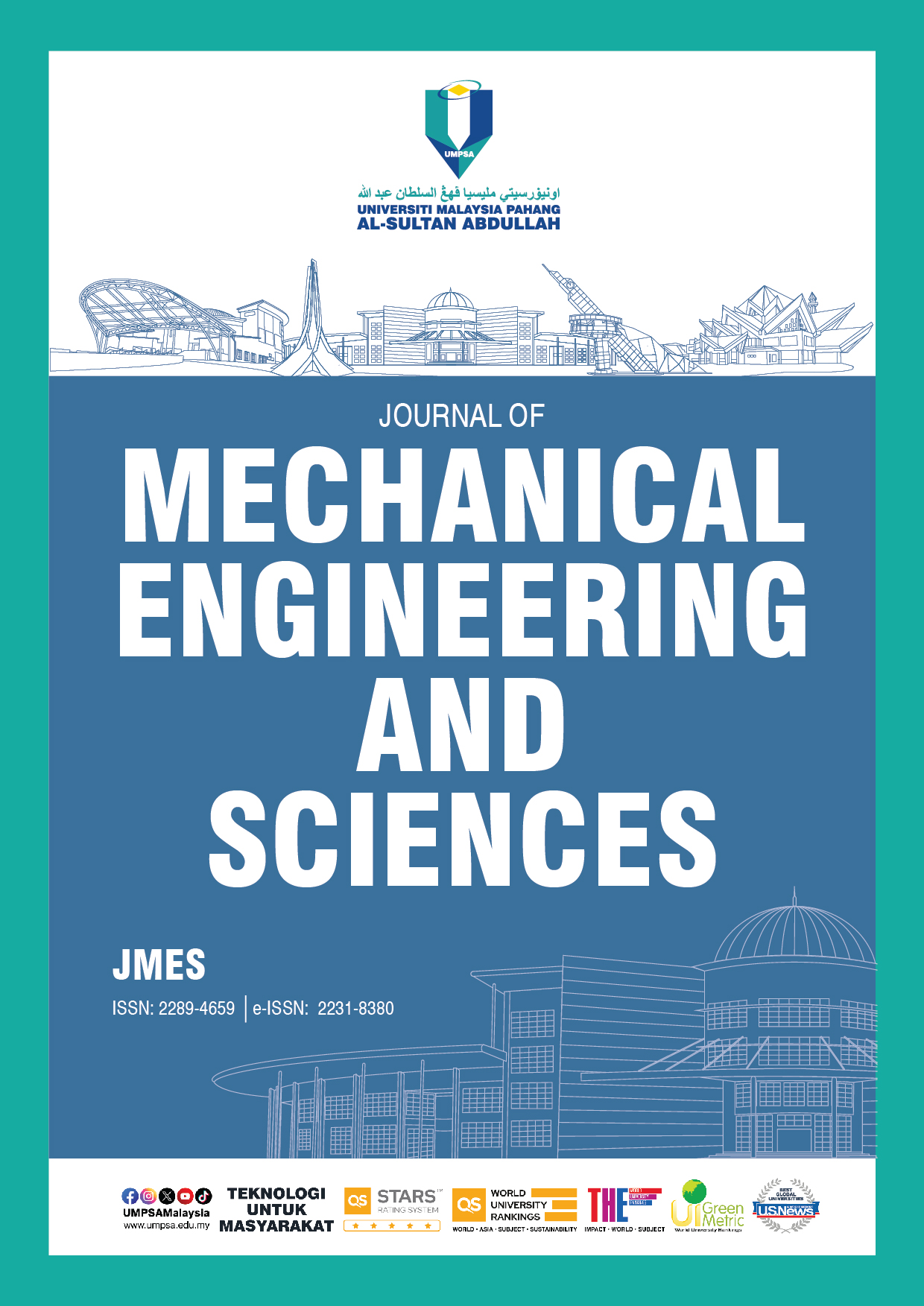Effect of cutting clearance in shear-slitting process on the residual stress and cut surface quality of AA6111-T4 aluminum alloy
DOI:
https://doi.org/10.15282/jmes.18.1.2024.2.0777Keywords:
Shear slitting, Cutting clearance, Aluminum alloy, Residual stress, Cut surfaceAbstract
The paper presents the problem of the correct selection of the cutting clearance during the cutting process of aluminum alloys on circular shears. Currently, production lines lack correct guidelines on how to set the cutting clearance depending on the type of aluminum alloy and its thickness. This causes defects in the products and accelerated wear of the cutting tools.The paper presents the results of experimental and numerical research related to the process of shear-slitting of t = 1 mm AA6111-T4 aluminum alloy. During the experimental studies, it was determined how the value of the clearance affects the characteristic features of the cut edge and deviations of the shape of the product. Using numerical tests, the influence of the clearance value on the stress values in the cutting zone was determined. For the AA6111-T4 aluminum alloy, the highest product quality was obtained using clearances hc = 0.09 mm and hc = 0.12 mm. The conducted experimental research can be useful on production lines in the aspect of the correct selection of technological parameters of the process due to the adopted energy and quality criteria.
References
M. Idzior, “Kierunki zmian materiałowych w motoryzacji w świetle wymogów ekologii,” Motrol, vol. 9, pp. 72-87, 2007 (in Polish).
S. F. Golovashchenko, “A study on trimming of aluminum autobody sheet and development of a new robust process eliminating burrs and slivers,” International Journal of Mechanical Sciences, vol. 48, pp. 1384-1400, 2006.
J. Kaczmarczyk, D. Gąsiorek, A. Mężyk, “Analiza numeryczna przyczyn powstawania defektów w ustalonym procesie cięcia płyt na gilotynach,” Modelowanie Inżynierskie, vol. 34, pp. 61-66, 2007 (in Polish).
T. B. Hilditch, P.D Hodgson, “Development of the sheared edge in the trimming of steel and light metal sheet. Part 1 - Experimental observations,” Journal of Materials Processing Technology, vol. 169, pp. 184-191, 2005.
S. Thipprakmas, “Application of Taguchi technique to investigation of geometry and position of V-ring indenter in fine-blanking process,” Materials and Design, vol. 31, pp. 2496-2500, 2009.
R. Hambli, M. Reszka, “Fracture criteria identification using an inverse technique method and blanking experiment,” International Journal of Mechanical Sciences, vol. 44, pp.1349-1361, 2002.
S. Ghosh, M. Li, A. Khadke, “3D modeling of shear-slitting process for aluminum alloys,” Journal of Materials Processing Technology,vol.167, pp. 91-102, 2005.
C. Liu, H. Lu, Y. Huang, “Dynamic steady-state stress field in a web during slitting,” ASME Journal of Applied Mechanics, vol. 72, pp. 157-164, 2005.
J. Ma, H. Lu, M. Li, B. Wang, “Burr height in shear slitting of aluminum webs,” ASME Journal of Applied Mechanics, vol. 128, pp. 46-55, 2006.
J. P. Wang, “A novel fine-blanking approach,” International Journal of Advanced Manufacturing Technology, vol. 78, pp. 1015–1019, 2015.
N. Wang, S.F. Golovashchenko, “Mechanism of fracture of aluminum blanks subjected to stretching along the sheared edge,” Journal of Materials Processing Technology, vol. 233, pp. 142–160, 2016.
H. Mao, F. Zhou, Y. Liu, L. Hua, “Numerical and experimental investigation of the discontinuous dot indenter in the fine-blanking process,” Journal of Manufacturing Processes, vol. 24, pp. 90-99, 2016.
H. C. Shih, M. F. Shi, “An innovative shearing process for AHSS edge stretchability improvements,” Journal of Manufacturing Science and Technology, vol. 133, 061018, 2011.
H. Du, W. F. Fan, Z. M. Zhang, “Comparative study of the process fracture between fine-blanking with negative clearance and conventional blanking,” Advanced Materials Research, vol. 97-101, pp. 191-194, 2010.
Q. B. Le, J. A. deVries, S. F. Golovashchenko, J. F. Bonnen, “Analysis of sheared edge formability of aluminum,” Journal of Materials Processing Technology, vol. 214, pp. 876-891, 2014.
S. Nasheralahkami, S. F. Golovashchenko, K. Pan, L. Brown, B. Gugnani, “Characterization of trimmed edge of advanced high strength steel,” SAE Technical Paper No. 2016-01-0358; SAE International: Warrendale, PA, USA, 5 April 2016; pp. 1–7.
T. B. Hilditch, P. D Hodgson, “Development of the sheared edge in the trimming of steel and light metal sheet: Part 2—Mechanisms and modeling,” Journal of Materials Processing Technology, vol. 169, pp. 192-198, 2005.
D. Gąsiorek, “The application of the smoothed particle hydrodynamics (SPH) method and the experimental verification of cutting of sheet metal bundles using a guillotine,” Journal of Theoretical and Applied Mechanics, vol. 51, pp. 1053-1065, 2013.
L. E. Schwer, “Aluminum plate perforation: A comparative case study using Lagrange with erosion, multi-material ALE, and Smooth Particle Hydrodynamics,” 7th European LS-DYNA Conference, Salzbug, Austria, 14-15th May, 2009.
K. Mori, N. Nakamura, Y. Abe, Y. Uehara, “Generation mechanism of residual stress at press-blanked and laser-blanking edges of 1.5 GPa ultra-high strength steel sheet,” Journal of Manufacturing Processes, vol. 68, pp. 435-444, 2021.
J. Stahl, D. Müller, I. Pätzold, R. Golle, T. Tobie, W. Volk and K. Stahl, “The influence of residual stresses induced by near-net-shape blanking processes on the fatigue behavior under bending loads,” IOP Conference Seres: Materials Science Engineering, vol. 651, p. 012086, 2019.
Downloads
Published
Issue
Section
License
Copyright (c) 2024 The Author(s)

This work is licensed under a Creative Commons Attribution-NonCommercial 4.0 International License.






